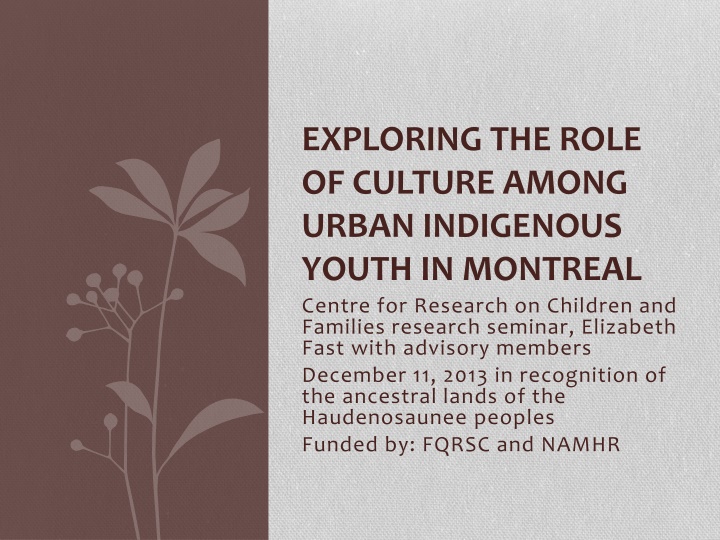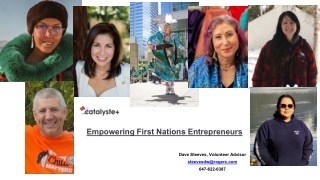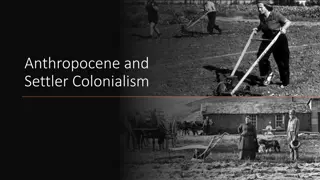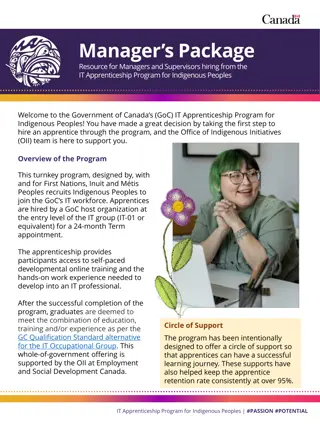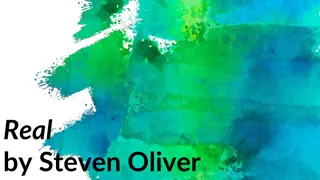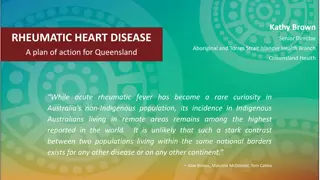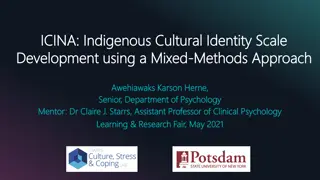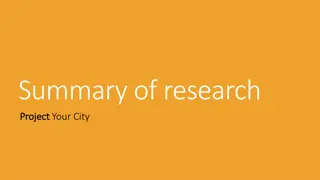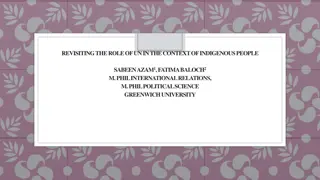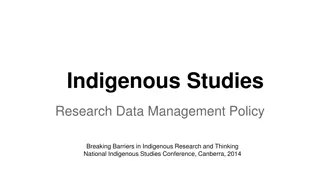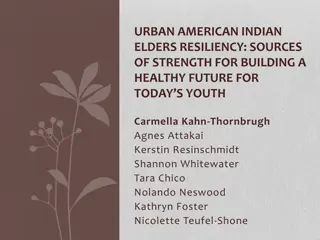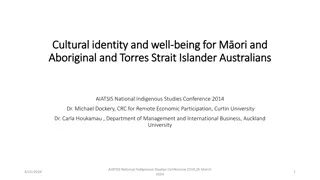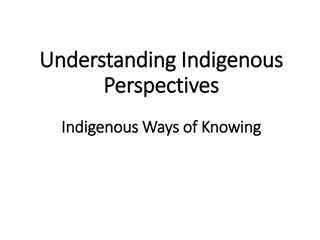Cultural Identity Exploration among Urban Indigenous Youth in Montreal
This research seminar explores the role of culture in the lives of urban Indigenous youth in Montreal, focusing on identity, decolonization, and the challenges faced by youth in maintaining their cultural heritage. It delves into the impact of urban migration on Indigenous populations and aims to understand how cultural practices can contribute to better mental health outcomes among urban youth.
Download Presentation

Please find below an Image/Link to download the presentation.
The content on the website is provided AS IS for your information and personal use only. It may not be sold, licensed, or shared on other websites without obtaining consent from the author.If you encounter any issues during the download, it is possible that the publisher has removed the file from their server.
You are allowed to download the files provided on this website for personal or commercial use, subject to the condition that they are used lawfully. All files are the property of their respective owners.
The content on the website is provided AS IS for your information and personal use only. It may not be sold, licensed, or shared on other websites without obtaining consent from the author.
E N D
Presentation Transcript
EXPLORING THE ROLE OF CULTURE AMONG URBAN INDIGENOUS YOUTH IN MONTREAL Centre for Research on Children and Families research seminar, Elizabeth Fast with advisory members December 11, 2013 in recognition of the ancestral lands of the Haudenosaunee peoples Funded by: FQRSC and NAMHR
Introduction Who I am and why I wanted to do this research Personal identity Professional experience Still struggling with identity, and can relate to the experiences of many of the participants
Research Question Few studies have examined the role that cultural identity plays in individual identity for urban Indigenous youth populations. Urban youth are of particular interest because they may be most at risk of grappling with their cultural identities They may not have the opportunity to come into contact with elders, extended family or community members to pass down cultural and spiritual practices, nor to learn about colonization and the meaning and potential role of de-colonization. This dissertation will ask the research question: what is the role of culture in the lives of urban Indigenous youth in Montreal?
Identity research and decolonization as a form of healing from trauma Decolonizing strategies is a very broad term and can encompass a huge range of activities from learning languages to making attempts to gain self government, to engaging in traditional activities and spiritual practices and employing liberation psychology (Chandler & Lalonde, 1998; Cornell & Kalt, 2007; Duran, Firehammer & Gonzalez, 2008; Torres Stone, 2006). There have been some studies done with on-reserve populations in the U.S.A. that have found culture and spirituality were associated with better mental health outcomes, particularly among youth How can these benefits be realized for urban youth? First it is important to understand what culture means for urban Indigenous youth
Urban Migration 54% of Aboriginal (those identifying as First Nations, M tis or Inuit) people now live in Canadian cities. A total of 291,035 Aboriginal people, or 25% of the total Aboriginal population in Canada, lived in nine of thirty-three metropolitan areas in 2006 (Statistics Canada, 2006) The most urbanized Aboriginal peoples are non-status First Nations peoples (or non-status Indians) and M tis, with 74 percent and 66 percent, respectively, living in urban areas. Status First Nations peoples (or Registered Indians) are less urbanized, with 38% living in urban centres, with about half of their population (52%) residing on reserves (and about 10% located in rural areas off reserve). Inuit are the least urbanized, with less than 30% living in an urban centre (Environics Institute, 2010). As of the 2001 census, the largest urban Indigenous populations were in Winnipeg and Saskatoon with 56, 000 and 41, 000 people respectively identifying as Indigenous (Statistics Canada, 2006). Montreal, which has a larger population overall, has 17,865 people that identified as Aboriginal in the 2006 census, which is less than .05% of Montreal s population. Between 2001 and 2006, the Aboriginal population of Montreal increased by 60% (Statistics Canada, 2006).
Urban Indigenous in Montreal Montreal is originally home to the Haudenosaunee, or the people of the Longhouse , often referred to as the Iroquois. The land of the Haudenosaunee people spanned from New York State to the province of Qu bec. Before the arrival of the Europeans, the St. Lawrence Iroquoians established the village of Hochelaga at the foot of Mount Royal (Canada, 1996c). Today, Montreal is the largest city in the province of Qu bec and is home people from 11 different First Peoples of Qu bec, Inuit, and other Indigenous and M tis that originate from communities across the country or that have lived in Montreal all of their lives (Native Friendship Centre of Montreal, 2002; StatsCan, 2005) Indigenous peoples living in Qu bec live in a different context than those in other provinces, partly as a result of the particular political history of the province. The settlement of New France in colonial times with a substantial French speaking population surrounded by primarily English speaking provinces led to a tumultuous history, particularly for non-French speakers living in the province. The 1960s and the Quiet revolution saw the rise of Qu bec nationalism and the revitalization of the French language as a symbol of nationalism implied the assimilation of non-French speakers into the rest of the population Dickinson & Young, 2002). It also masked the earlier history of the province and focused on the beginning of colonial history rather than the original inhabitants of the province.
Method Constructivist Grounded Theory (CGT) in interviews with 20 Indigenous youth living in Montreal; CGT attempts to build theory from the words of participants; 14/20 youth were interviewed twice to member check , or to verify that we had properly interpreted their responses; Interview guide developed in conjunction with advisory committee; asked general exploratory questions about participants lives and specific questions about definitions of culture, cultural identit(ies), where participants learnt about culture and social justice activities;
Urban Indigenous Advisory Committee In order to respect O.C.A.P. principles, an advisory committee was recruited to oversee the project, met 8 times during planning, interviewing and analysis phases; Paid as advisors, $35 per meeting (from NAMHR Grant); Before beginning project, agreed on research question and methodology, group felt that question was important for urban Indigenous youth and that interviews were appropriate research mechanism; Every time I met with academic committee, first I would meet with advisory committee Saw transcript exercepts, reviewed analysis and methodology chapters, and gave input into the shaping of the grounded theory model; Specific input around focusing on the resilient aspects of model vs. the trauma Brainstormed around dissemination, and participated in radio interview on CKUT in April, future dissemination of results will be ongoing
Recruitment and Interviewing Interviewees were recruited from several organizations and through word of mouth; Organizations included: Native Friendship Centre / Inter-tribal youth centre, Listserv / e-mails recruitment, Projet Ka Mamukanit, Centre Ivirtivik, Referrals from advisory committee members; Interviewees were paid $20/interview regardless of how long it took, and signed a consent form stating they could stop the interview at any time
Interview Guide Part 1: Exploratory questions What is your definition of culture? Or what are your ideas of what culture is? Can you tell me a bit about yourself? What makes you, you? What are some of the things that you choose to do and are passionate about? What is going on in your life right now? (how old are you? What is your level of education? What is your current work/school status? ) Where did you grow up? What were some of the most positive or negative events in your life that are important in understanding who you are as a person? (if they are comfortable answering this question) As a teenager, what were some of your favorite hobbies/sports/activities? When you were in high school, how did you picture your life? (What did you see yourself doing as an adult? Where did you see yourself living?) Has that changed now? What are your goals for yourself? Part 2: Identity questions What has culture meant for you in your life? Is there a particular culture that you identify with or want to identify with? Where /from whom did you learn about your culture? Are you interested in learning more about your culture? What steps are you taking to learn more? Is there anywhere that you go / anyone that you go to learn about what it means to be Indigenous(or Inuit, Mohawk, M tis, etc.)? Do you think that you could learn about your culture in Montreal or are you interested in returning to your community to learn more? How have your feelings about yourself/your culture changed over time? If you think back to when they were a teenager, what did being Indigenous/other culture mean to you? Have you ever participated in any demonstrations, protests or events promoting social change? Are you interested in social change? What kind of social change would you like to see?
FINAL SAMPLE Table 1: Demographic profile of participants, N=20 Sex Female:10 Male:10 18-22: 5 23-26: 7 27-30: 8 Heterosexual: 18 Gay/Lesbian/Bisexual/Transgendered: 2 Algonquin, Atikamekw, Cree, Dene, Innu, Inuit, Miq maq, Mohawk Atikamekw, English, French, Inuktitut, Mohawk Age Sexual orientation Nationality/Identity First languages spoken by participants Within biological nuclear family:15 Family upbrining Adopted/fostered or outside of nuclear family:5 English: 18 Language of interview French: 2 Less than high school, High school, College graduate, University graduate, Working on graduate level studies Employed full time, employed part time, full-time student, employment program (short term), Language/computer program (long term) Native Friendship Centre / Inter-tribal youth centre, Listserv / e-mails recruitment, Projet Ka Mamukanit, Centre Ivirtivik, Referrals from advisory committee members Highest level of education Current employment Recruitment
An emergent model of the role of culture among urban Indigenous youth CONTEXT: context of city living, definitions of culture, colonialism SUPPORTS AND BARRIERS: Supports: practical supports for urban living, cultural services and centres, healing centres; Barriers: Racism and lack of education on contemporary Indigenous people, internal shame PRE- CONDITIONS: Identity building: 2nd or 3rd generation, multiple identities, Cultural maintenance: 1st generation, single identity OUTCOMES: Identity building: belonging, pride, pan-Indigenous cultural identity; Cultural maintenance: belonging, cultural safety, culturally- specific identity STRATEGIES: Identity building: Connecting with Indigenous peers, working with other youth, re-connecting with family; Cultural maintenance: improving language, culturally-specific activities
Context The context of why, how and when a participant moved to Montreal was important in understanding their feelings about culture and identity There were different reasons people came to the city and different generations of migration Some of the themes were: To have access to services (housing, affordable food and basic necessities) To be close to family Came as a child with family Always lived in Montreal To get a fresh start
Context: Reason for moving to city Moved here with family as a child so parents could find employment: A was born in Nunavut and then moved to Montreal at 4 or 5 years old and M was born in Iqaluit, was in Montreal for kindergarten to grade 2, then in Inukjuak from grade 3 to grade 6 and has been in Montreal since grade 7 Lived here entire life: Yes, I was born in Montreal, my mom came here to study when she was younger with my brother, well my half-brother, I am M tis so for sure its different for me, cause I ve always lived in Montreal Came to be near family and access resources : In fact, one of my goals, was to come look after one of my nephews. My sister had come to live in Montreal 8 or 9 months before and I stayed in Manawan and I wasn t in school anymore. And there were no jobs, there was almost nothing to do, so I was hanging out with the wrong people and I realized it was time to get out of there (translated from French).
Context: Reason for moving to city Lack of affordable housing/living: It was too expensive to live up north and food and diapers are at least two times as expensive as they are in the city...In Iqaluit, everyone knows everyone else and everyone is drunk all of the time, a lot of people in my family have problems with alcohol (paraphrased). Fresh start: : Well you see I m gay, they don t accept gay people up there especially spiritually very demanding so one of the good reason I move down here is to live the way I want to live yeah .
Context: Definitions of culture Most participants had traditional definitions of culture; Language, worldview, ways of living and the way ancestors survived were all common responses; Most participants were very clear about what the word culture meant; Definitions grouped as: way of life, language, traditions and teachings and ambiguous
Context: Definitions of culture Culture as a way of life: Well, it makes me think of family, how we live and everything in the north. Culture is also a bit how we lived back in the day, for example how we made food and everything. Once a year I go up north to hunt or to see family. That s a bit Native culture, the way we get- together and everything . Culture as language: For me, culture is identity; there are a lot of things that come to mind, its identity or say language. I think its something that allows us to differentiate ourselves from others. Say, the Qu bec culture, the Anglophone culture, the Haitien culture, the Atikamek culture, its what differentiates us . (translated from French)
Context: Definitions of culture Traditions and teachings: Culture is like a teaching from the elders.... tradition, ways of life, how a person grows... I consider myself as an Inuk. Inuk is like one person and there is Inuit, meaning that is a lot of people and there are different dialects, different ways of saying. There is mind your own business, watch and learn yes and keep learning with the elders, whatever the elder says, it is better to follow their saying . Culture as ambiguous: I think first of all culture for me, there are so many different aspects of it because there s my personal identity with culture and you know my experience with culture . I played Inuit games, but I don t know much about culture. My father wanted me to get a formal education and not to be a hunter. My father was a water truck driver and got an education. There are still enough animals to hunt, but not enough ice and snow for them to survive for much longer .
Context: Experiences of colonialism linked to culture Many participants spoke of how events of the past continued to impact them to this day; Theories of historical trauma link colonial events to higher rates of addictions, suicide, poverty and other social issues; Participants particularly saw the cultural devastation caused by different aspects of colonization in their own lives and in those of their family and communities
Experiences of colonialism linked to loss of culture Well, with the elders, with the grandparents it is, but I think people because of the residential school my mother told me that in the residential school system you were encouraged I don t know - not encouraged but you were I guess forced not to speak your language, you were forced not to be who you were, so its a chain of events where my grandparents didn t speak to their children and they raised their children, you know English, Catholic, and you know we were the next generation and we didn t have any of that culture or any of that made us distinctly us, you know. So in a way I do feel like I ve lost a part of me . Like our culture, cause they killed all our dogs, we couldn t dog sled anymore, my grandfather always used to tell me all kinds of different stories and I don t know how, but I wish I could be the one to give the culture to everyone, every Inuit .
Experiences of colonialism linked to loss of culture like my grandmother on my mom s side, my mom was only 4 when she was taken away on a ship, saying that she was sick tuberculosis, but my grandfather as he recalls, there was no sign of her being sick or vomiting or nothing like that, my mom and grandpa always thought she was used for a guinea pig, cause she didn t return. And my mom went searching for her for many, many years and she finally found her (gravestone) in Hamilton she was upset about that for her whole life why - that was the big question . Yeah, a lot of the people cause they said the Innu people, they used to be very they would always move. They had, like I don t know, nobody could keep living like that, I don t know. White people, they looked at the Innu and they said, Sorry, you just can t do that. You can t have your whole community live in three places, like, and keep rotating all year round, you know. But that s what we used to do and we stayed healthy like that.. And we would kill caribou, we d kill everything and we d all survive as a family. We d be more tight together by always moving each season to a different place. But we stopped doing that and now we re stuck in one place. So, like, they re getting fat, they re getting more addictions, they re eating just sitting there and eating chips and, meat and, like, it s just and they re getting addicted to beer, they re running out of time, you know . like, greasy
An emergent model of the role of culture among urban Indigenous youth CONTEXT: context of city living, definitions of culture, colonialism SUPPORTS AND BARRIERS: Supports: practical supports for urban living, cultural services and centres, healing centres; Barriers: Racism and lack of education on contemporary Indigenous people, internal shame PRE- CONDITIONS: Identity building: 2nd or 3rd generation, multiple identities, Cultural maintenance: 1st generation, single identity OUTCOMES: Identity building: belonging, pride, pan-Indigenous cultural identity; Cultural maintenance: belonging, cultural safety, culturally- specific identity STRATEGIES: Identity building: Connecting with Indigenous peers, working with other youth, re-connecting with family; Cultural maintenance: improving language, culturally-specific activities
Pre-conditions to identity building or cultural maintenance Identity building Cultural maintenance 2ndor 3rdgeneration, mixed Indigenous , multiple identities or GLBT 1stgeneration, single identity Feelings of exclusion Processes that shape identity Amplified feelings of both pride and shame after moving to city Turning points Turning points
Pre-conditions to identity building or cultural maintenance Participants all had experiences that made them question their cultural identities; Many Identity building participants and Cultural maintenance participants had dual experiences belonging and exclusion; pride and shame; Both also had turning points that made them realize the importance of culture in their lives, many of these were during the youth years; Suspect that this cycle continues on throughout their lives and perhaps deepens
Identity Building pre-conditions Feelings of exclusion I am M tis so for sure for me its different, because I ve always lived in Monreal. In the past when I went to the Cote-Nord I experienced, you know not racism but I was treated differently, and when I m in Montreal its also different...Well because of my dad, because I didn t speak the language, they had a hard time believing, well not believing but like a judgement because I didn t speak the language, I didn t speak Innu, and also coming here it was different. I have a distinct first name ...(translated from French). Processes that shaped identity When I was a teenager, most of my cultural identity was you know through my father which was not a good experience. You know most of it was alcoholism and violence was most of my experience, and that s most of what I got as a teenager; that is most of what I saw. Now I see it is much more than that and I can understand it in a historical context, I can understand it in a much bigger broader way it is not so specific to one situation Turning Points My birth family, actually, I had lots of contact with them when I was young, like but then after I was put in that foster home I lost all contact with all my family. And I always missed them. I always you know, I always wondered who my family was growing up and I always you know, something was missing and I realized you know, I always felt I was going to go back home one day, see who my family is and when I went back when I was eighteen it s like they all remembered me and but I didn t remember them, you know .
Cultural maintenance pre-conditions Amplified feelings of both pride and shame after moving to city Well of course it really identifies who I am, that s for sure. I have a couple of friends that don t even eat like the way we eat. We eat raw, frozen and that s one of the best things, that I never want to lose. Especially the food, and you know like I m proud to be Inuk, that s for sure, and I m proud of myself to where I am today... we have sewing here sometimes and different little activities that keep us Inuk. But you know, I want to add something, sometimes I m embarrassed to be Inuk here. Like not here at this particular place, but I don t go to Atwater too often, I ll go to the mall, but I ll hide so I don t see any Turning points When I was growing up I like I the only thing I thought about was hanging out with my friends and like go play sports and stuff. But like now I m 20 years old and like starting to know what our culture means to us and like what s going on in the world right now and like you know. I don t know. Well, I know that there s so many people that they re Inuit but they don t speak Inuktitut. That s wrong. Well, it s not wrong. It s not our fault but
An emergent model of the role of culture among urban Indigenous youth CONTEXT: context of city living, definitions of culture, colonialism SUPPORTS AND BARRIERS: Supports: practical supports for urban living, cultural services and centres, healing centres; Barriers: Racism and lack of education on contemporary Indigenous people, internal shame PRE- CONDITIONS: Identity building: 2nd or 3rd generation, multiple identities, Cultural maintenance: 1st generation, single identity OUTCOMES: Identity building: belonging, pride, pan-Indigenous cultural identity; Cultural maintenance: belonging, cultural safety, culturally- specific identity STRATEGIES: Identity building: Connecting with Indigenous peers, working with other youth, re-connecting with family; Cultural maintenance: improving language, culturally-specific activities
Strategies for identity building and cultural maintenance All participants talked about things they had done, wanted to do or were currently doing to learn more about their cultures or try and maintain their languages and cultures in Montreal; Identity building youth were more comfortable or open to pan- Indigenous (cross-cultural) strategies, whereas cultural maintenance youth wanted more culturally specific strategies
Strategies for identity building Connecting with Indigenous peers no but you know, just to know that I made a new Native friend in Montreal, its already a good thing, especially when you re here, you re not with family or on the outside They re going to start a Native club at Dawson that I was interested in So that s going to be a big part of my culture, bringing it into my life more and like meeting new people and networking Working with other youth I wanted to live up north, that s one of the things, I wanted to stay up there to help younger generations to have a life, you know, not just rocky all the time, and direct them in the right direction... You know if I could I would go back and make proposals for programs for young ones and middle age and old people, you know it works only when you put it, you have to make it work . Like at this big employment fair, I did a bit of volunteering Slowly we are setting goals, its a kind of Indigenous network that s starting . Re-connecting with family I would like to get to know my blood family better. Like I know a little bit on Facebook or whatever but I d like to maybe like go back to my community some time and like live like their way of life because I think it s like more different than the way of life that I was brought up with and just to see different things . My birth family, actually, I had lots of contact with them when I was young, like but then after I was put in that foster home I lost all contact with all my family. And I always missed them .
Strategies for cultural maintenance Maintaining language Yeah. Like a course for If they know that person is an Inuit they should make a course just for those people in Inuktitut that s what I think, because in schools around here they don t have like Inuktitut course so all they talk about is English and French. So it will be better if they had a course Inuktitut for Inuits.... If there were more cultural teachings at the school, I would fell more part of his culture. The best cultural teachers would be elders or other Inuit. I am planning to return up North and hopefully learn the language there. My aunt tries to teach me Inuktitut, but it is difficult to learn (paraphrased) . Passing on culture to the next generation of youth I have another project I want to whenever I get the time because I learned to make amautis not everybody knows anymore, its something that lots of people don t know how to sew anymore so I want to teach people I want to be able to I was thinking maybe at the Friendship Centre, but I d need to work on that as a project, either that or it depends just something with amautis . Staying connected to culture through family or traditional activities I think every Indigenous person, no matter what their nationality, we like to go into the woods, often its what our ancestors did, its what instilled a little family, but we lose it a bit also, like kids that will be born soon will not have the chance to go, and its culture that gets lost, you could say its not important anymore, but for the Indigenous, there are, you know certain projects (translated from French).
Outcomes for identity building and cultural maintenance When participants had the opportunity to engage in the strategies they talked about, they mentioned feeling better about themselves, feeling more pride in their cultures and feeling more connected to other Indigenous people; Identity building: pan-Indigenous identity, belonging and pride Cultural maintenance: belonging, cultural safety, culturally specific identity
Outcomes Pride, positive cultural identity, belonging And, like, the reason why I had I got to go to powwows and, like, all these good things is because my brother, he was put in a different foster home. He was put in a Native foster home in Kahnawake... And, like, whenever he would go to cool events and stuff I d get invited..As a kid, it was awesome..I loved it . ...I started going to the First Peoples House at McGill and I started to meet other um Indigenous people my age and uh yeah, just making friends with other Indigenous really, really helped . Making dream catchers at home like it keeps me like calm and level and clears my head and like it keeps like a meditative state and it s positive, it s a positive I can bring my positive energy into it and just all of my positiveness and it s like I m using my if I m feeling better or whatever I just take the time and I am more positive. I feel more empowered now and embracing it is a good thing instead of denying it and taking it as a bad thing....It makes me feel like whole like there always was this gap that was missing and now it feels like that s what was missing and that s what I need to fill in . And it s also made me want to search for more of my culture and who I am because I like, many Indigenous people, you know, we ve lost a lot of ceremonies and our songs and and our dances. And, for me, I want to I feel like I m still on a constant search to find those things, and I feel like I ll be searching most of my life but I ll be learning as well as I go along and that will make my cultural identity grow .
An emergent model of the role of culture among urban Indigenous youth CONTEXT: context of city living, definitions of culture, colonialism SUPPORTS AND BARRIERS: Supports: practical supports for urban living, cultural services and centres, healing centres; Barriers: Racism and lack of education on contemporary Indigenous people, internal shame PRE- CONDITIONS: Identity building: 2nd or 3rd generation, multiple identities, Cultural maintenance: 1st generation, single identity OUTCOMES: Identity building: belonging, pride, pan-Indigenous cultural identity; Cultural maintenance: belonging, cultural safety, culturally- specific identity STRATEGIES: Identity building: Connecting with Indigenous peers, working with other youth, re-connecting with family; Cultural maintenance: improving language, culturally-specific activities
Supports Identity Building: More cultural centres/services Pan-Indigenous I d say lately I ve come across other Indigenous people and its from their reactions that I ve come to understand that it would be good if there were centres or something to get together, because I remember a reaction from someone that said, oh let s exchange phone numbers, I m looking for Native friends and me, without expecting that, I was like no problem! . So you know at the same time it made me realize that that it would be great to see that that s probably not the only person who feels that way, I don t think so anyways, you know I m sure she doubted that there were others here in Montreal (translated from French) .
Supports Cultural maintenance: Well, there was a church that was holding Inuit feasts like once a month but the church was bought so they don t have a place to do the feast anymore. And apparently it used to be every last Saturday of the month but they don t have that no more, you know, and I was thinking maybe, you know, maybe the centre could contribute something, you know, because we could do it. It s not something that s impossible. It s very possible, you know. Everybody Like everybody saying when are we going to have the feast, you know, because they get country food like caribou, fish, you know, bannock, you know, and little things like that .
Supports Indigenous Healing Centres / Activities The suicide rate is very elevated in every Indigenous community. Me, being there with nothing to do in a house, there are no jobs, you just eat, drink, consume, you just drink and if you have drugs you take them, sometimes money problems, fighting...Employment centres, I don t know, therapy centres, give a budget to Indigenous schools, there is nothing like that, nothing is offered for them. The only thing is the band councils that manage the money. And some communities aren t in agreement...And everyone aks why, why don t they get out of there and look for a job like any other immigrant? (translated from French).
Barriers Adjusting to urban living: Moving to Montreal is one thing that changed my drinking habits. I had no close friends or family, no work, there were people around but it was not good for me to hang around with them. It was a big change moving from a small place to a large place, there were different values and cultures.....There were too many buildings, everything has rules like you cannot jay walk, back home you can walk through the street without being pulled over. Also Montreal is different because its very diverse and I did not speak French (paraphrased) .
Barriers Lack of education / understanding / empathy about Indigenous issues But it needs to be presented in a positive view in you need to get the real story through through school. I mean, I don t understand why we don t have, like, a whole I mean, we have black history month. Why don t we have I think there s a Latino one too now, March or April...I mean, why don t we have a First Nations month that is solely dedicated to just teaching non-Natives about Indigenous culture... So I definitely think if things were presented more positively, I think if the marches stopped to educate people instead of just showing the sensationalized parts, I think it would be have a much better impact on teaching non- Natives
Implications for social work practice, policy and research Cultural needs: more opportunities to learn both culturally-specific and culturally-inclusive traditions and practices. Ottawa has some model programs. Also more Indigenous language courses Social needs: places to connect , ITYC cannot be one size fits all, need a variety of social and cultural spaces dedicated to Indigenous peoples Emotional needs: Culturally safe places to heal from intergenerational traumas Policy: better education on both historic and contemporary issues affecting Indigenous peoples, bending language laws in Qu bec for purposes of employment (barriers to working in French), Research: more French speaking participants, 1st, 2ndor 3rd generation and reasons for living in city all important distinctions Problematize non-Indigenous
